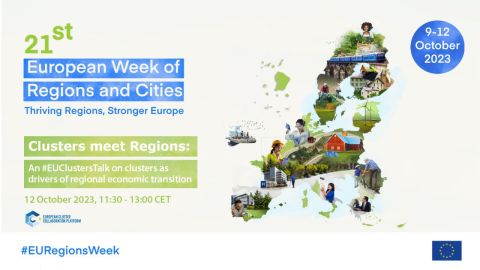
What is the role of clusters in the green and digital transition? And how do they collaborate with regional governments to strengthen the regional economy & build resilience? These are key questions for our EU Clusters Talk at the European Week of Regions and Cities. Together with our panellists and attendees, we want to explore the potential of clusters for regional policies, exchange good practices on how to involve clusters and discuss approaches for regional and interregional collaboration.
- EU/ European | Sustainable | Governance and Public administration | Industry, entrepreneurship and SMEs (enterprise/ startup/ business)
- Code: 12PL23260
- SQUARE Brussels Meeting Centre, Hall 100
Speakers
Moderator
Practical information
- When
-
Thu 12/10/2023, 11:30 - 13:00 CET
- Where
-
SQUARE Brussels Meeting Centre, Hall 100
- Format
- Participatory/Political lab
- Theme
-
Breaking barriers to cross-border cooperation
- Language
- English
- Website
-
https://clustercollaboration.eu/
- Social media
-
@Clusters_EU
@European Cluster Collaboration Platform (ECCP)

Partners
Reporting
Session summary
What is the role of clusters in the green and digital transition of Europe’s regions? How do they collaborate with regional governments to strengthen the regional economy and build resilience? These were the central questions at our in-person EU Clusters Talk, which the European Cluster Collaboration Platform organised as part of this year’s European Week of Regions and Cities. The Talk took place in the morning of 12 October 2023 and brought together representatives of public & research institutions, consultancies, and associations. The aim was for them to learn more about clusters, clusters’ work in the regions, and policy instruments to unlock innovation potential across EU regions.
Starting off the Talk, Wolfgang Münch, Deputy Head of Unit at DG REGIO, European Commission, presented the EU policy and cluster funding opportunities that are available through European initiatives. The Smart Specialisation Strategies support RD&I action with a total of 34.5 bn EUR until 2027. These funds help the actors in the region to bring about innovation. He also presented a S3-based cohesion policy tool for research and innovation: the Interregional Innovation Investment (I3) Instrument. It focuses on innovation closer to the market, specifically the demonstrate, commercialise, and scale-up new solutions. Another interesting instrument is the Smart Specialisation Community of Practice, a central node on guidance, networking, support, and peer-learning on smart specialisation. The services offer policy advice, give targeted support to regions, and engage stakeholders through events. Clusters can play an important role in usefully applying the cohesion funds.
Building on this thoughts, Marek Przeor made the connection to clusters. He reaffirmed that the EU economy's biggest advantage is the ability to work together and create trustful networks. There are over 1,500 cluster organisations registered on the European Cluster Collaboration Platform, which can lead the green transition, accelerate the digital transition, and build resilience: “By 2027, clusters need to lead the green transition!”. To do this, there are several financial and regulatory incentives for clusters to be involved in the regions, including the ECCP services to create collaborations and acquire knowledge. Collaboration can happen at both the regional and macro-levels, as clusters use the interrelations of actors in a certain space to create value.
Going to more concrete examples, Riikka Tanskanen, from the Regional Council of Lapland, spoke about the approach to innovation in East and North Finland. Clusters have been at the core of their smart specialisation strategies since 2019. They are now in the process of renewing their strategy, and they foresee clusters taking on an even bigger role than before. “We want clusters to take ownership of the strategy”, said Riikka Tanskanen. The clusters in the region have a high level of expertise combined with sustainable use of significant natural resources. They are, therefore, strong actors in the green and digital transitions of the region. “There is no sense to work individually, if we can do it together”, Rikka Tanskanen emphasised.
Kristina Šermukšnytė-Alešiūnienė, from AgriFood Lithuania, joined in the call to collaborate and use clusters as instruments for regional development. Their ecosystem encompasses many different stakeholders, and clusters are the frontrunners in uniting them and finding a common language. They “connect the dots” and create new possibilities for collaboration, which she illustrated with examples from Lithuania. They work as a hub to help with funding, bring knowledge to the ecosystem, support in acceleration, build the ecosystem for start-ups, and are active in skilling initiatives. Kristina Šermukšnytė-Alešiūnienė emphasised the importance of clusters working with regional governments and empowering the youth & women.
Talking about Clusters meet Regions, the speakers confirmed the usefulness of these events. Riikka Tanskanen highlighted them as important opportunities for clusters to present their work. Wolfgang Münch saw the benefit in the structural approach to speaking to administrations and finding a common language for voicing their needs. Adding to these points, Kristina Šermukšnytė-Alešiūnienė emphasised the possibility of talking about concrete actions. The Clusters meet Regions events (watch the video) offer a good platform to unite with the authorities and discuss what could be done – in this case, the help offered to Ukraine at the beginning of the war. Closing the discussion, Marek Przeor made the point that some governments might not have sufficient knowledge about the clusters in their regions and how they could be put to good use. As such, we need to continue working on the visibility of clusters and showcasing their potential.











